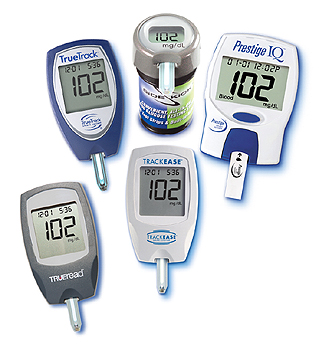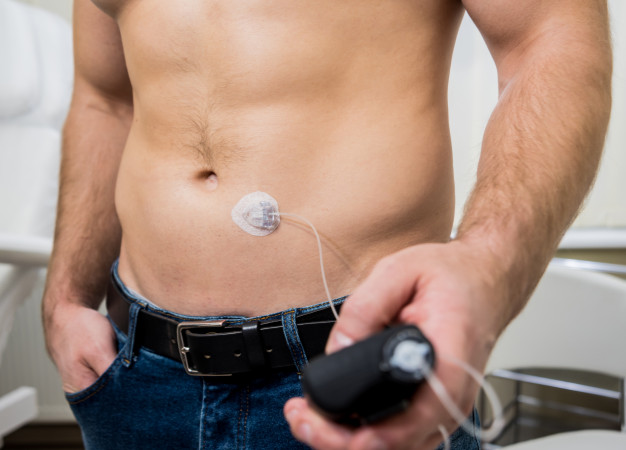Diabetes Treatments
QOL Tree
More Health Problems - Diabetes
Testing & Diagnosis
Pre-Diabetes
Types
Type 2 Risks
Symptoms
Treatment
Management
Hemoglobin A1C
Complications
Sick Day Self Care
Chronic Illness
Emotions
Breast Cancer
Treating Diabetes
- Treatments vary, depending on how high the blood sugar is
- A person has diabetes if:
- Fasting Blood Sugar (FBS) is at or over 126 mg/dl
- Oral Glucose Tolerance Test (OGTT) at 2 hours is 200 mg/dl or higher
Treatment efforts
- Diet and exercise
- Oral medications (pills)
- Insulin (by injection)
- Combination of diet, exercise, and medications
Diabetes medicines work in different ways. They:
- Help the pancreas make more insulin (the hormone)
- Help open the cells so the glucose can enter and provide energy for the cell
- Help the pancreas release more insulin after a meal
- Help the cells become more sensitive to insulin
- Lower sugar released by the liver
- Provide needed insulin for the body
Diabetes medicines
- Come in different strengths with varying lengths of action
- Some have rapid action
- Some are slow acting
- Some are long acting
- Many patients require a combination of the different medicines
- It is not unusual to try a number of different medicines before finding the right combination
- There are different types of diabetes medications
- There are pills to be taken by mouth
- Insulin is injected
- It can be the most common way with a syringe one or more times a day
- Or it can be injected by a pump and needle system which can give tiny doses of insulin throughout the day for very precise blood sugar control
- There also is insulin designed to be inhaled
- It may be necessary for you to take a variety of medicines (sometimes a combination of pills and injections) in order to keep your blood sugar in the normal range
- If you can keep your blood sugars in the range your health care provider recommends for you, you will feel better and be able to delay or avoid the complications of diabetes
- How much medication?
- How much, how often, and how to administer the medication depends on how well the glucose can be controlled by lab tests
- Your results from home glucose tests (often referred to as "home glucose monitoring") using a glucose meter
The Glucose Meter
- A glucose meter is a small device used to test for sugar levels
- A drop of blood is placed on a special strip that is inserted into the machine and the machine reads the sugar level
- A health care provider usually trains you on how to get a drop of blood or do a finger stick and then how to use the meter to read the glucose levels
- How often you should test your blood sugar
- How to adjust your medication based on what results you have gotten on the test
- How to use the meter

When pills do not help
- If the blood sugar is not responding to pills, diet and exercise, insulin may be prescribed
- More than one type of insulin may be recommended or tried in order to find a combination that works
- Delivering insulin
- Most individuals using insulin do so with a syringe
- If the person is having difficulty in controlling the levels of glucose, an insulin pump might be an option
- Pumps are expensive (several thousand dollars)
- There also is a powdered version insulin to use as an inhaler
Insulin Pump
Jared, can you crop out the top part of the photo?

- The pump is worn like a pager at the waist usually
- It has a tiny tube inserted under the skin
- The pump gives a basic dose of insulin throughout the day
- The person with diabetes can increase or decrease the amount of insulin depending on diet and activity
What is High or Low Blood Sugar?
- High blood sugar (hyperglycemia) is when the test show:
- At or over 240 mg/dl
Low blood sugar (hypoglycemia) is when the test show:
- Less than 70 mg/dl
- Dangerous blood sugar levels
- Anyone can have a high sugar level once in awhile, especially after eating something sweet
- If the sugar is below 70 mg/dl, you are at risk of low blood sugar (hypoglycemia) problems and need to eat a snack containing some sugar and some protein, for example, peanut butter and jelly
Hypoglycemia or low blood sugar can happen when:
- You are taking medication but not eating enough food
- You are exercising more but not watching your glucose (not checking your sugars)
- You are eating less and not watching your glucose
- You are taking too much medication
Signs of low blood sugar (hypoglycemia)
- shaking
- sweating
- rapid heart beat
- irritability
- headache
- confusion
- seizure
- severe hunger
Low blood sugar emergencies
- A blood sugar below 70 can become an emergency
- If the person is awake and can eat or drink something with sugar, that will raise the blood sugar
- If they are unable to safely swallow (that is, not choke), call 911 for help
- Low blood sugar can cause coma and death
High blood sugar and the Dangers of Ketoacidosis
- Diabetic ketoacidosis (DKA) is not common with type 2 diabetes, but can happen with uncontrolled high blood sugar over a period of time
- DKA happens when the body cannot use the glucose normally
- The sugar builds up
- The body starts to break down fat for energy and this causes the blood to become acidic
- This can lead to many complications, including death
- Blood sugars with DKA are usually between 600 and 1,000mg/dl
What causes diabetic ketoacidosis (DKA)?
- When the sugar level is over 600 mg/dl
- It can cause dehydration (loss of body fluids), which makes the sugar level even higher
- The build up of acid in the blood stream from breaking down fat for energy (since the sugar can't get into the cells) affects breathing, heart function, and consciousness
- Death can occur if insulin, fluids and other medication is not given promptly
- A medic-alert card or bracelet can save your life!
For the unexpected medical emergency:
- Always carry a medic-alert card in your purse or wear a bracelet that indicates you have diabetes
- This helps paramedics and doctors know how best to treat you when there is an emergency
- Living with diabetes can mean a good quality life
- Dangerously low or high blood sugars occur rarely or never if an individual takes care of themselves:
- Takes their medications
- Checks their blood sugars
- Lives a balanced life, eating a healthy diet and doing regular physical exercise